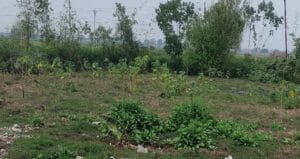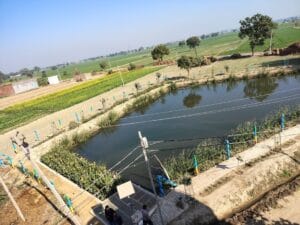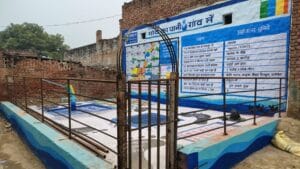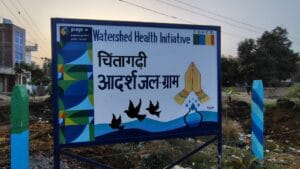गांव का पानी गाओं में
Motiram is the Pradhan [Elected Village Head] of a small village Chintagarhi under the Chandgarhi Panchayat of Hathras Block. The village has only 119 households mostly resided by the socio-economically backward scheduled cast. The village mostly dependent upon farming activities and allied farming activities such as labour. A few of them also earn their livelihood through selling vegetables and working in the rice mill that is situated in the village.
Motiram, 56, is however the soil of soil wanting to do something extra for the village and the community members. Only in April 2021 he got elected overwhelmingly with the support of the community members with a promise to improve the situation of the village. It however never came into his mind that one way of serving the people would come in the form of water harvesting and it would be brought by an external agency.
In early 2024 while FORCE was developing intervention plant for Hathras block for its Watershed Health Initiative project funded by PepsiCo India, we came across this village and Motiram who readily agreed to transform his village to z zero water outflow village by restoring the wastewater pond [that never was] and allowing FORCE to create as many rainwater harvesting structures in the village as needed.
He also passionately supported us in building a learning centre in Chintagarhi.
We chose Chintagari for its ideal size – small enough for ease of implementation, yet big enough to offer replicability learnings and for the sheer enthusiastic Motiram to do something for his people.
The Constructed Wet Land Chintagarhi, a year back had an area that was demarked by the panchayat as a collection point for the wastewater from the village. However, over the years this place became a marshy place that has reduced the wastewater flow to a small drain that through a channel went to the nearby farm- untreated while the exit point – approx. 3000 sq.m. of silted up, marshy land near the main road – at one end of the village. Also over the time it was a dumping point for garbage for the community and was a source for filth and water borne disease. Part of that land was also used as a livestock waste dumping site. The possibility of being able to use this land to develop a new pond was a key factor influencing our decision to make Chinta Garhi a model GPGM village.

After we approached Motiram, he saw an opportunity to create a constructed wetland and pond which can serve the dual purpose of cleaning wastewater and storing treated wastewater along with rainwater runoff which could be used by farmers for irrigation.
We initiated the earthwork and dug 3 meters deep at the centre with proper bunds on the sides. When the pond was ready with the proper channelization of wastewater, the baffle chambers were created for de-silting and de-greasing. Thereafter a reed-bed of three meter deep, two meter wide and ten meters long that bears over 100 plants that bio digest the wastewater. The village pond with capacity of 5058.6 cu.m. made that gets treated wastewater through the reed bed. The boundaries of the wetland now bears plants that doubly treat the wastewater and also has a barbed wire fencing to protect any trespass by the villagers or their cattle.

The Four RWH Structures Apart from the wetland we have FORCE also constructed 2 new rainwater harvesting structures having a capacity of 1067 cu.m. 2 Defunct water structures restored with 765.16 KL capacity. One of the RWH has been created in the upper primary school located in the village itself. It is now a centre for attraction and learning space for the children.
The school by itself has developed a garden were water efficient farming on a small scale is done through broad bed system. The school also bears creative all across the walls – on RWH, climate smart agriculture, WASH learnings etc.
With the pond approximately filled four times a year the total water harvested annually stands to be 1.69 crore liters per year [16.9 million liters]. The total Capacity thus created is 1.88 crore liters of water.
Learning Centre Another site has been developed especially for children as a ‘learning through play’ kind of learning center. An RWH puzzle and a snake & ladder game encourages children to learn about water conservation, rainwater harvesting and how they can reduce their water footprint.
The impact is – the village now has got a new look with migratory birds visiting the pond. The number of fishes that were release there on the World Fisheries Day in November 2024, have grown. It has become a landmark in the district as Chintagarhi is the first Zero Water Outflow Village. People often visit this village and meet Motiram for advice.
So much so that the government officials regularly visit this place and inviting FORCE to develop other such places in the district and are now ready to handover the charge of Jal Shakti Kendra mandated by the Jal Shakti Ministry of Government of India.
Motiram is a people’s hero now. FORCE and PepsiCo India thank him for all his support to maje Chintagarhi a Model Water Village [
